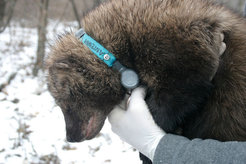Knowledge benefits conservation

In the past, the Swainson's hawk was an everyday sight during the summer for farmers in western North America: the raptors sat for hours on the posts of electric fences, keeping a lookout for prey – insects and rodents. In winter, they assembled in large flocks and flew to Argentina to spend the winter. Suddenly, in the mid-1990s, the buzzards disappeared.
Biologists then fitted several animals with transmitters and tracked them on their flight to South America. The researchers finally discovered the reason for their declining numbers in their wintering areas in Argentina: the farmers there treated their fields with pesticides to protect them from insects. The Swainson's hawks were ingesting the pesticides with the grasshoppers and died as a result. According to estimates, tens of thousands of birds perished in this way. Since then, bird conservationists and local farmers have been trying to control the use of pesticides so that they no longer poison the buzzards. Their stocks have subsequently increased again.
The example of the Swainson's hawk shows that the more we know about an animal species, the better we can protect them. This applies particularly to animals that move around a lot – migratory birds, marine animals and some mammals. They are exposed to many hazards on their travels and many die in the process. But in the case of most species we do not know how big the losses are, where they die and how they die. Countless numbers of them fall victim to hunters, for example. Ornithologists estimate that, each year, on their stopovers around the Mediterranean, in Egypt, Libya, Cyprus, Malta and even in Italy and the south of France, hundreds of thousands of birds are caught in nets or shot.
If scientists are familiar with the migratory routes of endangered bird species and know where their roosting places are, appropriate conservation areas can be designated. A satellite-based telemetry system like Icarus also provides important data for species protection. The project will also help to protect animals that do not set off on annual migrations. The data contained in Icarus about the behaviour and the habitats of a species shows the living conditions that a species needs to survive and where areas of retreat should be established accordingly.
Moreover, existing protected areas need to be linked to one another as there are only a few large connected habitats currently in existence. Instead, nature reserves and national parks are located, island-like, in a sea of settlements, roads and agricultural land. For many species, the human cultural landscape is an insurmountable barrier. Protected areas alone are too small to accommodate viable populations of one species. Furthermore, the lack of interaction genetically impoverishes the populations: they lose their genetic diversity and run the risk of becoming extinct as a result.
Conservationists and scientists therefore want to unite the protected areas with one another. Corridors ensure that the animals remain in contact in the individual areas. For example, individual animals looking for new territories can move through these corridors. The animals passing through are frequently young animals that have just gained their independence. We know from movement analyses of large land-based predators like wolves, leopards or pumas that young animals frequently leave nature reserves and migrate several hundreds of kilometres through terrain that is inhospitable for them. Migration corridors could increase the survival chances of these animals and prevent a species from fragmenting into isolated groups.
But how do we know where a corridor should run? In the end, the most scenic route is of no help if the animals don't use it. In particular, the green bridges, built at a cost of millions, and which the wild animals are supposed to use to cross carriageways or motorways, are often situated at unsuitable locations, and are therefore used by only a few animals.

Neither are theoretical considerations and calculations of much help, as scientists working with Martin Wikelski discovered. They attached GPS transmitters to fishers close to the city of Albany in upstate New York and then analysed their movements. They saw that the animals cross man-made countryside like golf courses or cemeteries to get from one place to another. Most of these migration corridors run differently to the predictions of theoretical calculations. In future, Icarus will provide even more data so that authorities can establish green corridors in such a way that endangered species can benefit the most from them.
Conflicts between humans and animals are another concern for conservationists: bears that come too close to humans; herds of elephants that leave their reserves and trample farmers' fields; tigers that attack people. Icarus can erect a type of “virtual fence” around protected areas. It can use its location and movement data to warn people about such unwanted encounters with wild animals. As a result, precautions can be taken and damage can be limited.
And, if nothing else, Icarus will make the lives of animals, their needs and the threats to which they are exposed directly tangible. Anyone who can track a jaguar in the South American rainforest or the travels of storks across continents will campaign more forcefully for the protection of these animals in future. All the more so, if, as a “citizen scientist”, he or she becomes a researcher themselves and can provide their own observations to the scientific community using smartphone apps like Animal Tracker. As a result, Icarus will help to inspire even more people to get involved with nature and species conservation.

